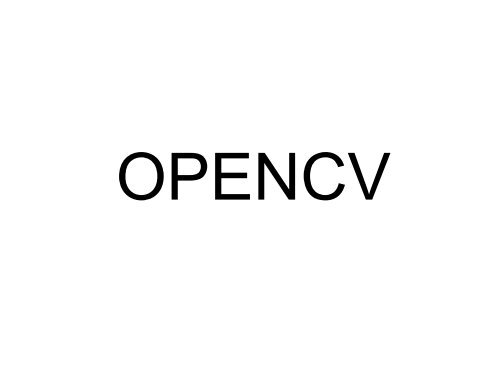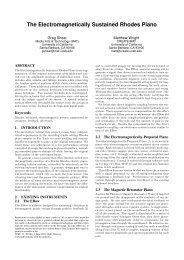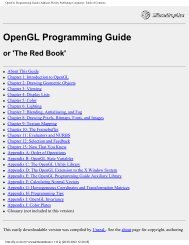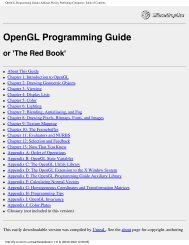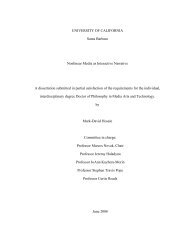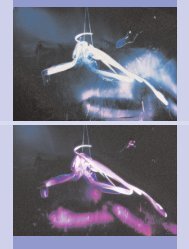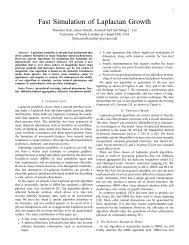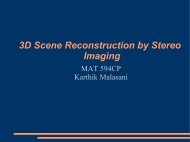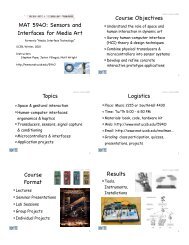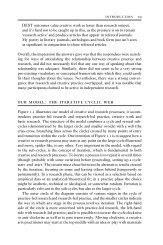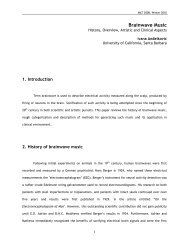OpenCV pdf
OpenCV pdf
OpenCV pdf
Create successful ePaper yourself
Turn your PDF publications into a flip-book with our unique Google optimized e-Paper software.
OPENCV
Mac Ox alternative to opencv installation<br />
According to:<br />
http://opencv.willowgarage.com/wiki/Mac_OS_X_<strong>OpenCV</strong>_Port<br />
(Method 2)<br />
If you do not have macports, install it<br />
http://www.macports.org/install.php<br />
On a new shell, install cmake<br />
sudo port install cmake<br />
Check out the openCV sourceCode<br />
svn co https://code.ros.org/svn/opencv/trunk/opencv<br />
From the opencv directory run Cmake<br />
sudo cmake -G "Unix Makefiles"<br />
sudo make -j8<br />
sudo make install
Compile the application as:<br />
gcc -o Ej2C ejemplo2ymedio.c -I/usr/local/include/opencv<br />
-L/usr/local/lib -lopencv_core -lopencv_highgui -lopencv_ml<br />
-lopencv_video -lopencv_imgproc -lopencv_calib3d
Windows installation on VS 2008<br />
Download the 2.1 installer<br />
http://sourceforge.net/projects/opencvlibrary/files/opencv-win/2.1/<strong>OpenCV</strong>-2.1.0win32-vs2008.exe/download<br />
Restart the computer<br />
Follow the instructions on;<br />
http://opencv.willowgarage.com/wiki/VisualC%2B%2B_VS2010
Library structure<br />
From: Learning <strong>OpenCV</strong>, Gary Bradsky & Adrian Kaebler O’Reilly 2008
Example 1. camera capture and GUI<br />
Example 2. Simple image manipulation<br />
Example 3. RGB splitting<br />
Example 4. Using masks<br />
Example 5. Edges<br />
Example 6. Pseudo color
Example 7 Non linear mapping<br />
(x,y)<br />
Example:<br />
u<br />
v<br />
Input<br />
= x cos<br />
=<br />
y<br />
( y)<br />
Inverse Transform<br />
(u,v)<br />
Output
Example 8 Histogram Backpropagation<br />
x 1 0<br />
4<br />
4<br />
3 . 5<br />
3<br />
2 . 5<br />
2<br />
1 . 5<br />
1<br />
0 . 5<br />
0<br />
0 0 . 1 0 . 2 0 . 3 0 . 4 0 . 5 0 . 6 0 . 7 0 . 8 0 . 9 1
Ex9 Cam-shift color-Tracking<br />
The mean-shift Algorithm:<br />
7 0 0 0<br />
6 0 0 0<br />
5 0 0 0<br />
4 0 0 0<br />
3 0 0 0<br />
2 0 0 0<br />
1 0 0 0<br />
7 0 0 0<br />
6 0 0 0<br />
5 0 0 0<br />
4 0 0 0<br />
3 0 0 0<br />
2 0 0 0<br />
1 0 0 0<br />
0<br />
0<br />
0 5 0 1 0 0 15 0 2 0 0 2 5 0<br />
0 5 0 1 0 0 1 5 0 2 0 0 2 5 0<br />
1. Define a window<br />
2.find the mass center
7 0 0 0<br />
6 0 0 0<br />
5 0 0 0<br />
4 0 0 0<br />
3 0 0 0<br />
2 0 0 0<br />
1 0 0 0<br />
7 000<br />
6 000<br />
5 000<br />
4 000<br />
3 000<br />
2 000<br />
1 000<br />
0<br />
0<br />
0 5 0 10 0 15 0 200 2 50<br />
0 5 0 1 0 0 1 5 0 2 0 0 2 5 0<br />
3. Re-center the windows<br />
repeat 2-3 to convergence
Cam-shift Algorithm<br />
1. Find the object histogram.<br />
2. Calculate the histogram backprojection on the search<br />
window.<br />
3. Iterate the mean-shift algorithm to find the mode on x and<br />
y dimensions.<br />
4. Update the center and window dimensions.<br />
5. Go to step 2


